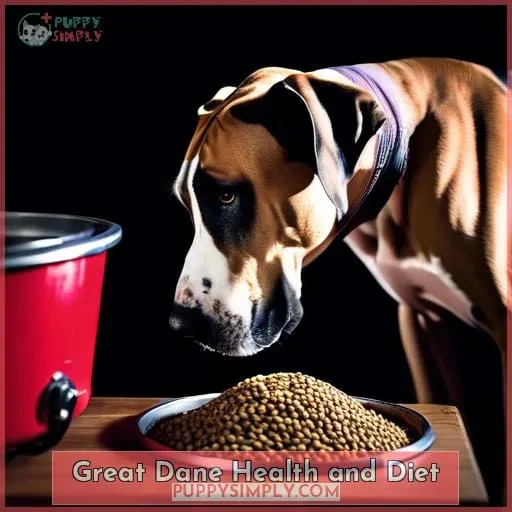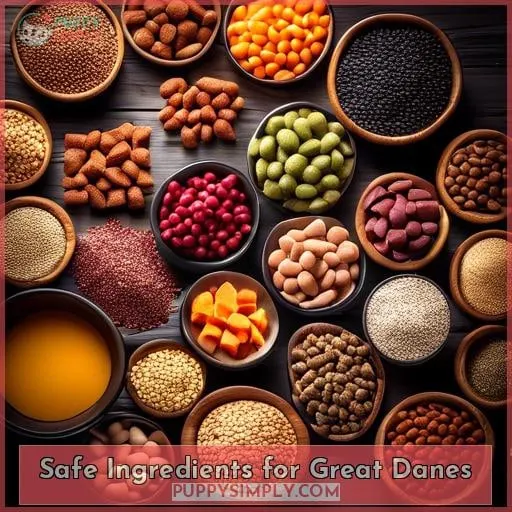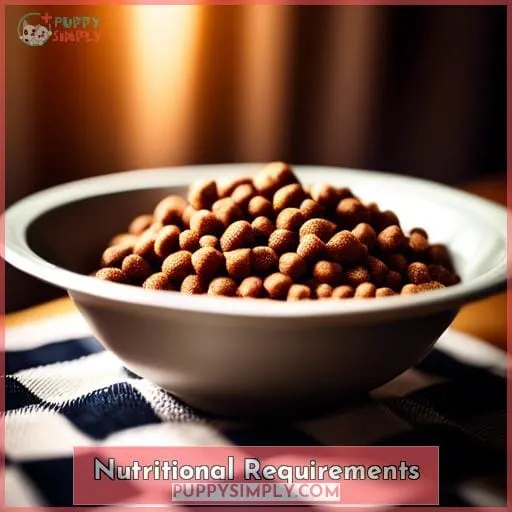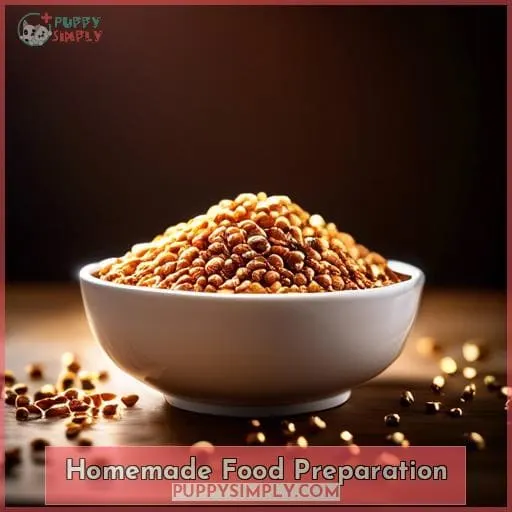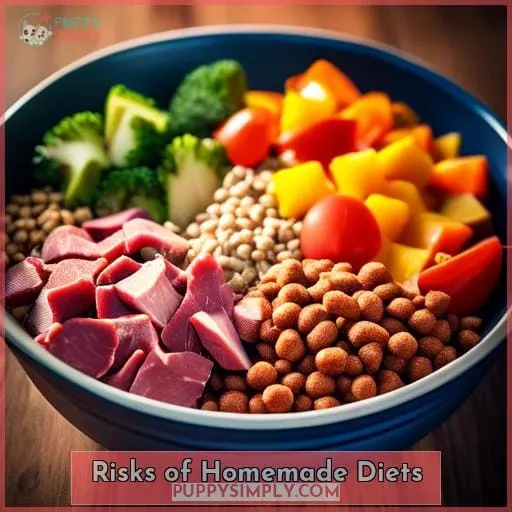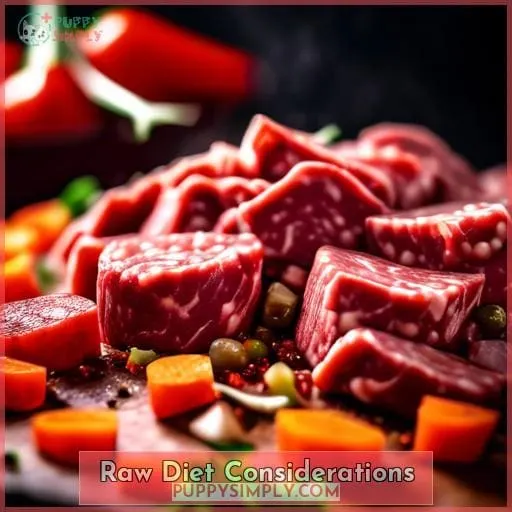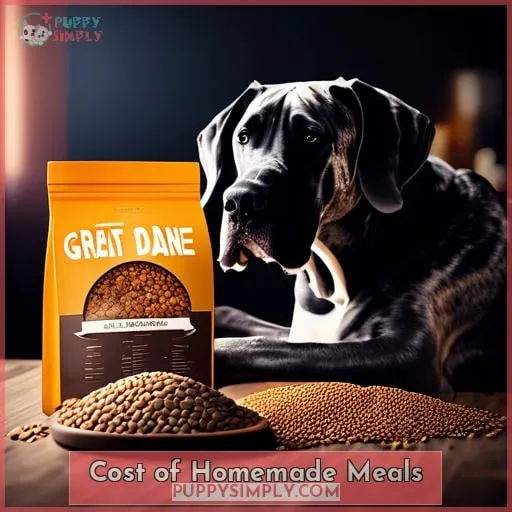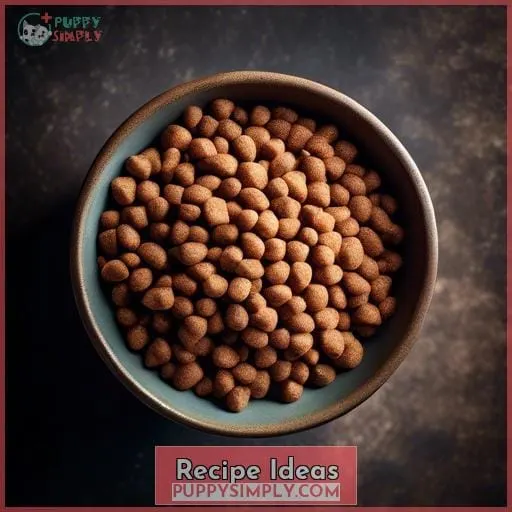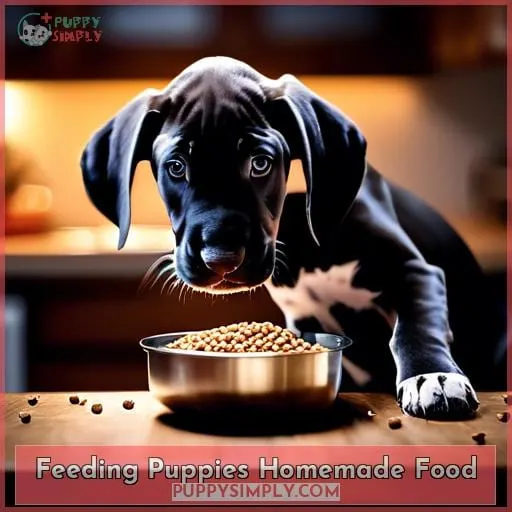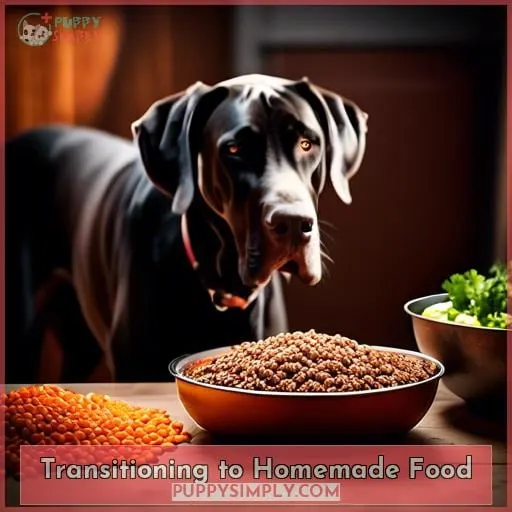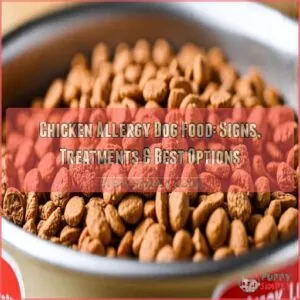This site is supported by our readers. We may earn a commission, at no cost to you, if you purchase through links.
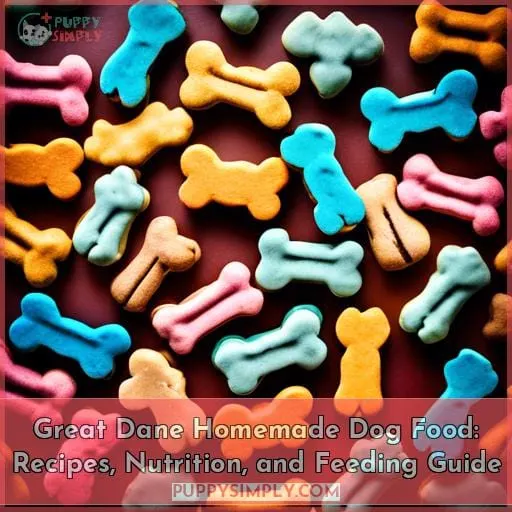 Imagine being a gourmand Great Dane, longing for sustenance that satiates your majestic frame and discerning palate.
Imagine being a gourmand Great Dane, longing for sustenance that satiates your majestic frame and discerning palate.
Your owner, driven by love and concern for your well-being, embarks on a culinary adventure, crafting great Dane homemade dog food that nourishes your body, mind, and spirit.
This comprehensive guide will equip you with the knowledge to create delectable, nutritious meals that will keep your Great Dane thriving and their tail wagging with delight.
Discover the secrets to a balanced diet, explore safe ingredients, and uncover the art of preparing wholesome meals that cater to your Great Dane’s unique needs.
Table Of Contents
- Key Takeaways
- Great Dane Health and Diet
- Safe Ingredients for Great Danes
- Nutritional Requirements
- Homemade Food Preparation
- Risks of Homemade Diets
- Raw Diet Considerations
- Cost of Homemade Meals
- Recipe Ideas
- Feeding Puppies Homemade Food
- Transitioning to Homemade Food
- Frequently Asked Questions (FAQs)
- Conclusion
Key Takeaways
- Tailor homemade diets to individual dogs’ health issues and nutritional requirements.
- Use fresh, whole ingredients like lean meats, vegetables, healthy fats. Avoid toxic foods like onions, chocolate.
- Properly balance nutritional components like protein, carbs, fats. Support muscles, tissues, energy, growth.
- Carefully prepare recipes to maintain nutrients. Prioritize digestible carbs and quality proteins.
Great Dane Health and Diet
You can adjust your Great Dane’s homemade diet to address health issues like allergies or arthritis.
Homemade food offers more control over ingredients, ensuring your dog gets the nutrients they need while avoiding those that trigger health problems.
Fresh, whole foods can improve your dog’s overall health and well-being.
Dietary Adjustments for Health Issues
- When your Great Dane is facing health challenges, you’ll need to modify their diet to support their specific needs.
Work with your veterinarian to create a tailored plan that addresses their unique condition.
Nutritional supplements, ingredient substitutions, and careful monitoring can help manage allergic reactions, digestive health issues, weight problems, and more.
Benefits of Homemade Food
Customizing your Great Dane’s diet with homemade food gives you greater control over their nutrient intake, ensuring they receive optimal nutrition tailored to their unique needs.
Fresh, whole ingredients promote better digestion, reducing the risk of stomach upsets and allergies.
The palatability of homemade meals often excites even the pickiest eaters, encouraging a healthy appetite.
Moreover, preparing meals at home can be cost-effective compared to commercial dog food, especially for large breeds like Great Danes.
Safe Ingredients for Great Danes
When making homemade food for your Great Dane, stick to safe ingredients:
- Lean meats: chicken, turkey, beef, lamb, and fish
- Low-carb vegetables: broccoli, cabbage, zucchini, and greens
- Healthy fats: olive oil, coconut oil, and fish oil
Avoid ingredients toxic to dogs: onions, garlic, grapes, and chocolate.
Also avoid feeding table scraps, which can be high in fat and salt, leading to health problems.
Provide a balanced diet that meets nutritional needs.
Include a variety of safe ingredients and avoid toxic ones.
Nutritional Requirements
You’ll need to ensure your Great Dane’s homemade food provides the right balance of protein, carbohydrates, fats, and minerals.
Protein sustains muscles and tissues.
Carbs fuel energy.
Fats support growth.
Minerals perform various functions in the body.
Protein and Carbohydrate Needs
Now that you’re aware of the safe ingredients for your Great Dane, let’s discuss the protein and carbohydrate needs of these large, active canines.
Protein variety and digestibility matter. Choose high-quality sources like lean meats, poultry, and fish.
Carbohydrates provide energy and fiber. Opt for digestible sources like white rice, oatmeal, and sweet potatoes.
Achieving a balanced macronutrient profile is essential for optimal health and vitality.
Importance of Fats and Minerals
Fats and minerals are essential to your Great Dane’s overall health.
Fats provide energy, support cell function, and aid in nutrient absorption.
Minerals, like calcium and phosphorus, help build strong bones and teeth, support nerve and muscle function, and maintain fluid balance.
Without a balanced diet rich in these nutrients, your Great Dane may suffer from skin problems, digestive issues, and a weakened immune system.
Dietary supplementation or adding fat sources like fish oil and mineral-rich foods like bone meal can help ensure your dog gets the nutrients they need to thrive.
Homemade Food Preparation
When preparing homemade food for your Great Dane:
- Balance the diet to ensure it meets their nutritional needs.
- Consider cooking practices like boiling, baking, or steaming to maintain nutrient integrity.
Additionally, consult with your veterinarian to create a tailored diet plan that addresses your dog’s unique health requirements.
Balancing the Diet
To ensure your Great Dane’s homemade diet is balanced, carefully select ingredients and adjust portions to meet their nutritional needs.
Prioritize high-quality protein sources like lean meats, fish, and eggs.
Include digestible carbohydrates such as white rice or sweet potatoes for energy.
Add a variety of vegetables for essential vitamins and minerals.
Balance fats with omega-3 and omega-6 fatty acids.
Consider supplements for calcium, phosphorus, and other nutrients as needed.
Plan meals to ensure nutrient ratios are met and digestive health is maintained.
Cooking Practices
When cooking homemade food for your Great Dane, follow safe practices to ensure a wholesome, bacteria-free meal.
Slow cooking is a gentle method that preserves nutrients and flavors. It’s ideal for giant breeds like Great Danes, promoting easy digestion and optimal nutrient absorption.
Consider your dog’s individual needs and consult a veterinarian or canine nutritionist for a balanced diet tailored to their health goals.
Risks of Homemade Diets
You run the risk of nutritional imbalances and potential health issues if you don’t carefully plan and prepare your Great Dane’s homemade meals.
Nutritional education is key to understanding your dog’s dietary needs.
Nutritional Imbalances:
Without proper knowledge, you may unintentionally create meals lacking essential nutrients or containing harmful ingredients.
Ingredient Sourcing:
Ensuring the quality and safety of ingredients can be challenging, especially when dealing with raw meat and produce.
Recipe Testing:
It’s crucial to test recipes thoroughly to ensure they’re safe and palatable for your dog. This may require time and resources.
Veterinary Consultation:
Consulting a veterinarian is crucial before starting a homemade diet. They can help assess your dog’s individual needs and guide you in creating a balanced meal plan.
Raw Diet Considerations
In balancing your Great Dane’s raw diet:
- Include raw meaty bones to promote dental health, prevent boredom, and provide calcium and phosphorus.
- Feed poultry sparingly due to its high omega-6 and low mineral content.
- Prioritize red meat for its iron and zinc richness.
- A raw diet may be easier to prepare than a home-cooked diet, but ensure you research and consult with a veterinarian to create a balanced and nutritious meal plan.
Raw Feeding Considerations
To ensure a balanced diet for your Great Dane on a raw food diet, variety is key.
Offer a mix of:
- Muscle meat
- Organ meat
- Bones
- Raw vegetables
Introduce new foods gradually to prevent digestive upset.
Monitor your dog’s weight and body condition to ensure they’re getting the right amount of nutrients.
Consider consulting a holistic veterinarian for personalized guidance.
Safety first: always handle raw meat with care to prevent contamination.
Balanced Diet for Health
Although raw diets can be simpler to prepare than cooking, you should still ensure that your Great Dane’s diet is balanced and complete.
Achieve this by:
- Maintaining nutrient ratios
- Offering ingredient variety
- Monitoring digestive health
Adjust the diet seasonally and consider dietary supplements to address specific needs.
Poultry vs. Red Meat
When considering a raw diet, poultry is high in omega-6 and low in minerals, so feed more red meat.
Red meat is preferred for a cooked diet. Pork, beef, lamb, and other red meats are suitable.
Feed approximately 0.5 ounces of beef liver daily for copper.
Cost of Homemade Meals
Now, let’s address the elephant in the room: the cost of homemade meals.
We know you’re a savvy shopper, always looking for ways to stretch your dollar.
Here’s the scoop: preparing homemade meals for your Great Dane can be a budget-friendly endeavor, but it requires some planning and strategic sourcing.
- Buying ingredients in bulk can save you a pretty penny.
- Consider joining a CSA or farmers market to score fresh produce at a discount.
- Look for sales and coupons to slash your grocery bill.
- DIY alternatives like making your own broth or grinding your own meat can also trim costs.
Recipe Ideas
Let’s explore some easy-to-make recipes that provide optimal nutrition for your Great Dane.
For a delightful treat, try the Blueberry-Banana CBD-Infused Dog Treats that support:
- Skin and coat health
- Digestion
- Reduction of allergic reactions
If you’re looking for a classic favorite, the Chicken & Rice Delight ensures a nourishing and tasty meal.
Blueberry-Banana CBD-Infused Treats
By making Blueberry-Banana CBD-Infused Treats, you’re providing your Great Dane with a nutritious and delicious homemade snack.
Settle on the appropriate CBD dosage based on canine weight, reactions, and needs.
Shape dough into bite-sized pieces, taking care to avoid grapes or chocolate.
Store unused portions in the fridge for freshness.
Try substituting peanut or almond butter for variation.
Exercise prudence with CBD and consult your veterinarian.
Delight your Dane through wholesome homemade creations.
Chicken & Rice Delight
Your Great Dane will love this classic chicken and rice recipe that ensures they get a nourishing and delightful homemade meal.
- Boiled chicken breast provides lean protein.
- White rice for easy digestion.
- Carrots for vitamins and fiber.
- Olive oil for healthy fats.
- Low sodium chicken broth enhances flavor.
Directions:
Feeding Puppies Homemade Food
When feeding puppies homemade food, you’ll need to adjust portions frequently for proper growth and development.
The nutrient ratios required by puppy diets differ from those for adult dogs.
Monitor your puppy’s growth rate and body condition score, increasing portions as they grow.
Weigh puppies weekly and feed a developmental diet tailored to their life stage, starting with twice the amount of calories per pound that an adult dog requires.
Gradually transition puppies over 2-3 weeks from commercial to homemade food to avoid gastrointestinal upset.
Consult your veterinarian and reference AAFCO nutritional guidelines when formulating homemade puppy diets, ensuring adequate protein for growth and the right balance of fat, carbs, vitamins, and minerals.
Transitioning to Homemade Food
When transitioning your Great Dane to a homemade diet, do so gradually over 7-10 days.
Slowly increase the homemade food percentage while decreasing the previous food.
This allows time for digestive adjustment to the new food.
Plan out recipes and shop for ingredients in advance.
Make meals in bulk and freeze individual portions in sealed containers.
Start with blander recipes and introduce stronger flavors slowly.
Keep a feeding log to monitor health changes.
Use homemade bone broth or water to adjust consistency.
Frequently Asked Questions (FAQs)
How much homemade food should I feed my Great Dane per day?
Feed your Great Dane 2-4% of his ideal body weight in homemade food daily.
Split this into 2-3 meals.
Adjust as needed to maintain optimal body condition.
Consult your vet for specific calorie needs.
What are some homemade food recipes that are easy and quick to prepare?
Bake chicken and sweet potatoes.
Stir ground beef, carrots, peas, and brown rice.
Mix canned fish, eggs, oats, and yogurt.
Focus on quality ingredients tailored to your dog’s needs.
What kitchen tools and equipment do I need to prepare homemade dog food?
You’ll need a food processor, kitchen scale, storage containers, supplements, blender, slow-cookers, pots, pans, utensils, and ingredients tailored to your Great Dane’s needs.
For preparing balanced, nutritious homemade meals:
How can I store and preserve homemade dog food safely?
Portion and seal meals in freezer bags.
Thaw in the fridge or microwave before serving.
Avoid contamination with proper sanitation when preparing and storing.
Monitor temperature and shelf life closely.
Conclusion
Contrary to popular belief, homemade dog food takes more than just tossing table scraps into Fido’s bowl.
Carefully crafted recipes using wholesome ingredients tailored to your Great Dane’s needs ensure proper nutrition.
Although homemade meals require effort, your faithful companion is worth it.
Providing your Great Dane homemade dog food made with love fosters health, happiness, and the human-canine bond.

